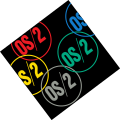OS/2
 | |
| Developer | IBM Microsoft (1.0–1.3) |
|---|---|
| Written in | C, C++ and assembly language |
| Working state | Historical, now developed as ArcaOS |
| Source model | Closed source |
| Initial release | December 1987 |
| Latest release | 4.52 / December 2001 |
| Marketing target | Professionals, servers |
| Available in | Chinese, English, French, German, Italian, Japanese, Korean, Spanish, Portuguese, Russian |
| Platforms | x86, PowerPC |
| Kernel type | Hybrid kernel |
| Influenced by | MS-DOS, IBM PC DOS |
| Default user interface | Workplace Shell Graphical user interface |
| License | Proprietary |
| Succeeded by | First by eComStation, then ArcaOS |
| Official website | OS/2 Warp (Archived) |
OS/2 is an operating system that was originally made by a joint agreement between the Microsoft and IBM companies. The name stands for "Operating System/2". It was intended to replace MS-DOS and Microsoft Windows. OS/2 was maintained by IBM until 2006.
IBM discontinued its support for OS/2 on 31 December 2006. Since then, it has been updated, maintained and marketed under the name eComStation. In 2015 it was announced that a new OEM distribution of OS/2 would be released that was to be called ArcaOS.
References
[change | change source]OS/2 had true multi-tasking. As a demonstration, ten 1 million line files were each put on display to screen in ten separate windows. On Windows 3.1, only one at a time had display activity. On OS/2, all ten displays moved uninterrupted simultaneously. IBM LAN Manager also had better measurable performance, being based on an OS/2 server. This was in the early 1990's.[1]
- ↑ I was an OS/2 specialist and IBM LAN Manager Network Administrator with LA DWP, working there from 1990 to 2015.
